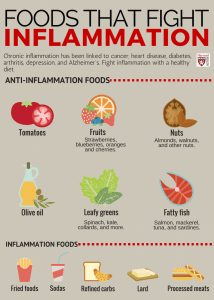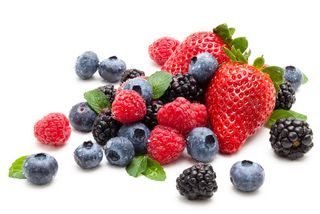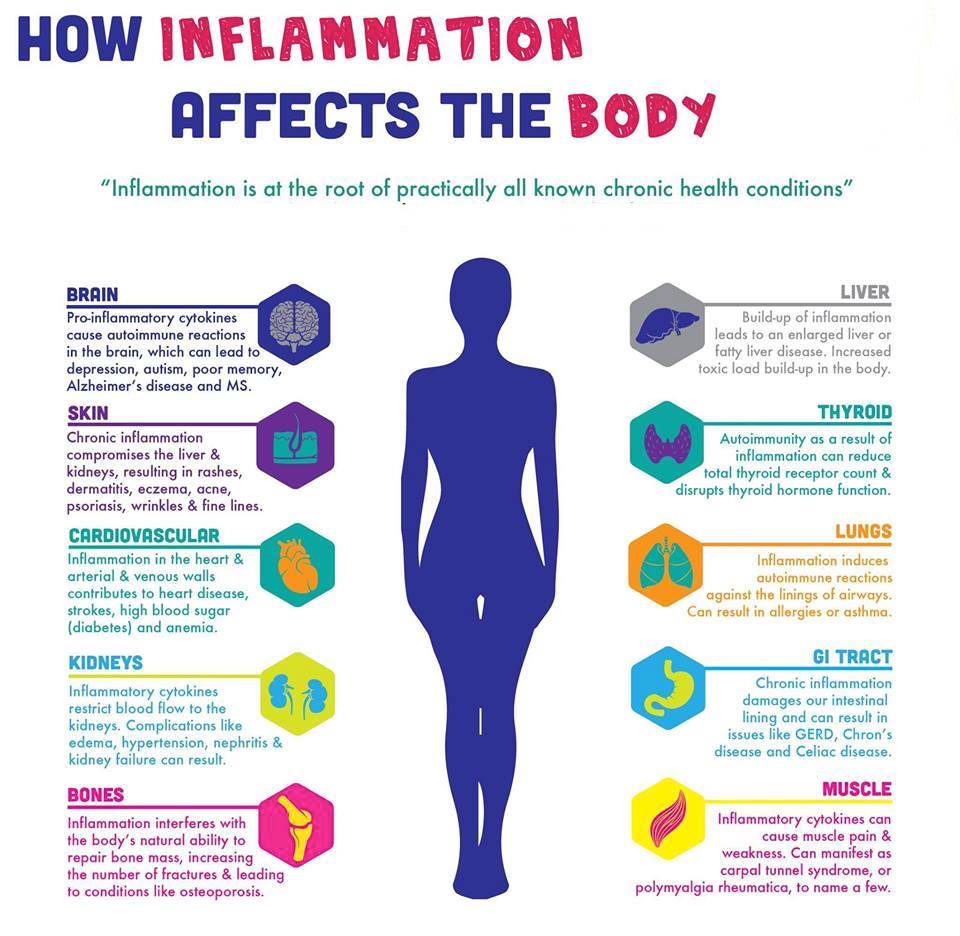At complete chiropractic, we see lots of clients looking to improve their general health and well being. One of the most talked about issues in this regards in inflammation – an often invisible condition which potentially serious health effects. This week, Dr Irvine talks inflammation prevention through simple tweaks to the diet.
Inflammation is the body’s natural response to injury or infection. The inflammation process cleans out damaged tissue and sets the stage for healing to begin – fundamentally this is a good thing, however if something interferes with the complex chemical balances of the immune system, the body can fail to produce anti-inflammatory responses. In this case, inflammation becomes chronic, rather than being a temporary reaction.
While it might not seem it, chronic inflammation can represent a real risk to our health – the negative effects of chronic inflammation can range from allergies to life-threatening diseases.
Headaches, back pain and neck pain are however, some of the most common symptoms people report. Over the longer term, Chronic inflammation can also manifest as an autoimmune condition, such as fibromyalgia, lupus or rheumatoid arthritis – where the body reacts to a non-existent threat and attacks its own tissues.
While the above symptoms are problematic, they are at least noticeable – ln some cases, chronic inflammation can be mild enough to go unnoticed and yet cause significant cumulative damage over time to one or more organs or systems. The possible results can include cancer. heart disease, diabetes or osteoporosis.
Lets talk food

Fortunately, its possible to reduce and control inflammation by making smart health choices. Regular chiropractic care, coupled with the right food choices can go a long way.
Research tells us that what we eat is directly associated with blood levels of C-reactive protein (CRP) – we now know that CRP can be used as a reliable marker for measuring inflammation. A typical modem diet — heavy in refined grains, sweets and other processed foods — correlates with high CRP levels. Obesity, also rampant today. leads to higher levels of chronic inflammation[1]
Thankfully, eating to prevent chronic inflammation is not complicated — an anti-inflammatory diet is broadly compatible with the general wellness advice that we provide our clients are part of their chiropractic care.
Antioxidants
One of the most powerful weapons in the fight against inflammation are simply fruits and vegetables are rich in anti-oxidants, such as vitamins A. C and E, and selenium. These nutrients protect cells from damaging chemicals known as free radicals. Further, there is evidence to suggest that antioxidants alone show promise for the treatment of the immune-deficiency conditions that arise from chronic inflammation.[2]
Another tool are Flavonoids. Flavonoids are an array of chemicals found in foods. which also offer powerful antioxidant effects – you’ve probably heard about these “superfoods” recently – Berries and Cherries are good examples, which both contain a flavonoid called anthocyanin. And its not just exotic and unusual berries! – An investigation at the Harvard School of Public Health showed lower blood levels of CRP in women who regularly consume plain old strawberries[3] .
Another favorable option are the Carotenoids — you might guess from the name that these are the compounds responsible for the striking orange color of winter squashes carrots and sweet potatoes— also have strong anti-inflammatory properties.
Other foods reputed to be rich in inflammation-fighting antioxidants include asparagus, broccoli peppers. tomatoes. Spinach, red wine and even dark chocolate (although at complete chiropractic, we recommend you choose a variety of foods.. not just the chocolate!)
Vitamin D also helps regulates inflammation. Vitamin D is synthesized by the skin in response to sunlight and also occurs naturally in liver and fatty fish.
Vitamin K is anti-inflammatory as well, suppressing key chemicals in the inflammation process[4] Vitamin K is probably less well known than many of the others – you can find vitamin K in most dark leafy greens, as well as eggs, meat and dairy products.
While on the subject of fruits and vegetables, I would recommend an organic source wherever possible – non organics might be cheaper, but some of the pestisices in common use have also been linked to inflammation – avoid them altogether if you can, but wash thoroughly if you cant!
CLA
Recently there has been a great deal of coverage regarding conjugated linoleic acid (CLA) – a fatty acid abundant in meat and milk from grass-fed animals[5]. CLA is also found in eggs, particularly those from free range birds. Research shows that CLA is a potent antioxidant, and there are even some suggests that it may possess anti-cancer traits. in addition CLA appears to be a useful tool in combating heart disease[6] .
Essential Fatty Acids
The essential fatty acids — omega-3 and omega-6 are so named because they cannot be manufactured by the body, its therefore essential that we obtain them from food sources. Omega-6 functions to activate the immune system and trigger inflammation, whereas omega-3 converts into powerful compounds that counteract the inflammatory response. You might wonder if simply eliminating Omega 6 from the diet can reduce inflammation – but unfortunately it’s a little more complicated! The body does require both acids in order to function normally, so a total exclusion is off the cards, but we can help ourselves to avoid problems by trying to get a balance of both.
Many modem health problems can be traces to the disproportionately high ratio of omega-6 to omega-3 fatty acids in today’s Western diet. One of the worst culprits is cooking oil – many common vegetable oils are high in pro-inflammatory omega-6 which most of us need to reduce in our diets. These include palm, soybean, canola. and sunflower oils -try to cut down if you can.
It’s not just inflammation which is a factor here either – the omega-3 known as docosahexaenoic acid (DHA) is an important building block of the brain. DHA consumption is critical to prevent inflammation of the brain, which is a precursor to many diseases of the central nervous system[7] .
Thankfully omega 3 is fairly easy to integrate into the diet – Fish is the most prominent source of omega-3, particularly DHA. Choose wild fish over farmed fish to maximize the anti-inflammatory effects – this is becase we now understand that the DHA itself comes not from the fish, but from algae and plankton in their natural diet. In fact, research indicates that farmed tilapia and catfish have a high ratio of omega-6 to omega-3, compared with naturally raised varieties[8].
That being said, when shopping for seafood, it is essential to steer clear of varieties with high levels of mercury or other contaminates. which may lead to heavy metal poisoning. Swordfish, bluefish and some varieties of tuna are among the most highly contaminated.
If fish isn’t your thing then some nuts and seeds are excellent sources of omega-3 fatty acid. They are particularly rich in a specific omega-3 called alpha- linolenic acid (ALA). Flaxseeds, flax- seed oil and chia seeds are among the most potent sources of ALA, while walnuts contain a modest amount as well.
Spicy Solutions
Throughout history, Certain spices have been revered around the world for their medicinal qualities – two of these are proven effective against inflammation: turmeric and ginger.
Turmeric — responsible for curry powder’s yellow color — has been used in traditional Indian medicine for centuries to counteract inflammation. Modem research now confirms that turmeric is particularly effective against rheumatoid arthritis[9] and it is fair to assume that the same applies to other forms of inflammation.
Ginger, on the other hand, is actually as effective at reducing swelling as non-steroidal anti-inflammatory drugs. Research shows that it suppresses certain biochemical processes of chronic inflammation. Unlike conventional drugs. however, ginger has minimal side effects.[10]
Ongoing research indicates that a myriad of other herbs and spices may ward off inflammation. So it’s a good idea to cook with m many of these natural flavor boosters as possible.
Trans Fats & Sugar: Two to Avoid
When it comes to preventing chronic inflammation, two foods are best avoided altogether: Trans fats and sugar.
Trans fats are already an infamous nutritional villain. They are synthetically produced by adding hydrogen atoms to certain unsaturated fat molecules — hence they are also known as hydrogenated oils. A revealing study demonstrated up to 73 percent higher levels of the inflammation marker CRP in individuals in the top 25 percentile of trans fat consumption[11].
Common sources of trans fat to avoid include margarine, vegetable shortening and many processed foods. Refined sugar and high fructose com syrup found in many processed foods and drinks triggers spikes in blood sugar. These spikes lead to subsequently high insulin levels in the bloodstream. This causes honnonal changes that throw the immune systems out of balance and encourage inflammation. Research confirms that heavy consumption of sugar increases inflammation while a low—sugar diet can dramatically lower it[12]
Foods to avoid
While the foods we have just discussed can help to reduce inflammation, others can actually promote or cause inflammation. A diet too high in red meat, for example, may instigate inflammation. As a general guide, a balanced diet high in fruits and vegetables is the best way to go.
Finally, check out this info-graphic – which shows just how badly inflammation can affect us!

[1] Arch Intern Med 2007; 167:3 1-9).
[2] Eur .1 Clin Nulr 2008;62: 127-37
[3] J Am Coll Nurr 2007;26:303- l 0
[4] Med Hypotheses 2010; Epub
[5] J Dairy Sci 2000;83:l0l6-27
[6] Nutr Metab 2010;7:5
[7] J Neurochem 2007;101:577
[8] J Am Diet Assoc 2003;108:1178-85
[9] Arthritis Rheum 2006;54:3452-64
[10] J Med Foad 2005;8:l25-32
[11] J Nutr 2005;135:562-6
[12] Physiol Behav 20l0; 100:47-54; Am J Clin Nutr 2005; 82:42 1-7

